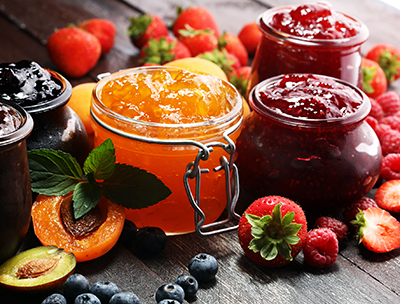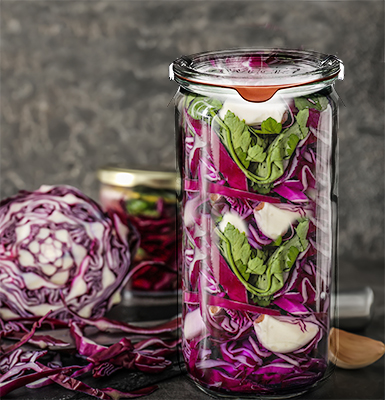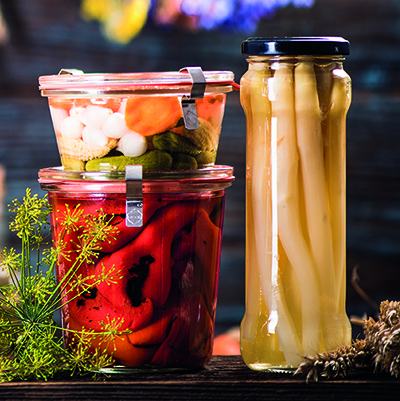
Preserving, pickling and fermentation are very popular at the moment – even before the beginning of Corona pandemic. A lot of peple rediscoverd preserving, pickling and fermentation of food before tooth paste, flour and toilet paper got rare articles in our supermarkets.
Basically preserving has always been present. There are people who like to preserve fruits and vegetables from their garden, garden plot or the preferred farmer around the corner. Nevertheless most people remember preserving thinking back to the old days when grandma's cellar was full of jars filled with cherries, beans, beetroot or other food.
Preserving was considered old-fashioned as times of need were long past. Nearly any vegetable or fruit – it doesn't matter if exotic or not, of fresh or prepacked – is available at any time of the year.

There are different reasons why preserving, pickling and fermentation are popular these days:
Using the right ingredients
Preserving a good strawberry jam you should just use strawberries and sugar – and maybe some vanilla and rhubarb. On the other hand you may sometimes wonder if so many other ingredients are needed when reading the list of ingredients of prefabricated products. Preserved food isn't only important for people who suffer from allergies or lactose, fructose, gluten or some other intolerence caused by industrial products. Preserving allows you to use the exact ingredients you desire such as biological and sustainable food or fruits and vegetables from your own garden.
Self-made food with individual taste
Diversity is one of the key issues of preserving. Even if there are innumerable varieties you always create and converse your individual taste. Some may be surprised about the taste of self-made peas. This doesn't mean canned peas have a bad taste. it's just different.
Simply sustainable
Preserving, fermentation and insertion cause a lot of work. You have to harvest or buy food, cut it, boil it, start a brew out of it, preserve it and fill it into jars. Moreover you need for preserving – for empty jars, equipment like a preserving pot and the storage of the preserved food as the whole is just worth the effort if you preserve bigger quantities. On the other hand preserving is sustainable. Jars and closures can be reused several times. Preserving doesn't cause any packaging waste and even buying and preparing regional food at home helps to shorten transport routes that are characteristic for industrial food sold at the supermarket.

Preserving is the generic term. Nevertheless nothing is said about the kind or rather the method of preserving as there differences.
In German sometimes the term "Einwecken" is used to describe the process of preservation, but this term is under global trademark protection by the company J. Weck GmbH u. Co. KG. Nevertheless it's about "cooking" filld goods (i.e. fruits, meat, vegatables etc.) in closed jars at a definied temperatur between 85°C and 100°C over a longer period of time. When the jars cool down after preserving a vacuum is formed inside the jar. if the jar stays closed (when swing top and WECK clamps are removed) the process of preserving has worked. You can preserve food in a water bath, an oven, a pot, a preserving cooker (cookers with an autonomous energy supply, termperature sensor and timer) and even in a food processor.
Despite the generic term pickling is often used as synonym for the hot filling of marmelade and jam. Beyond the high temperatures it's the high sugar concentration that makes the content be conserved for a long time.
The difference with the insertion is after all that this method doesn't need any cooking or heating. Food can be inserted in oil, sweet and sour liquids.
Fermentation is a special form of insertion. Basically fermentation is the oldest, documented form of conserving food. A lot of things we eat are fermented: sauerkraut, coffee, tea, yoghurt, beer, ham, salmon and soya sauce. If you like to ferment something you insert the vegetables, fruits, meat etc into a salt brine – water with a sal concentration between two and five percent. Then you wait for three to five weeks. The fermenting food doesn't have to be stored in the fridge, but in the flat, pantry or cellar. It's important that the filled goods are always covered by the brine during the fermenation process.
The special effect of fermantation is that food changes its quality. Good (!) microbes desintegrate the food and taste gets more intensive (read about it here: http://www.einkochwelt.de/en/nice-to-know/fermentation/. As gases are formed during fermentation the jars must always be open slightly or ventilated regularly – more or less every two to five days.
An important aspect of preserving, fermentation and insertion is that clean jars and accessories have to be used. Thus before preserving, fermenting or inserting jars, rings, clamps and tools should be boiled for three to five minutes in water at temperatures between 90°c and 100°C. Eventually you may add two or three splashes of vinegar. Later let the jars and accessories dry on a clean ktichen towel and fill the jars swiftly.